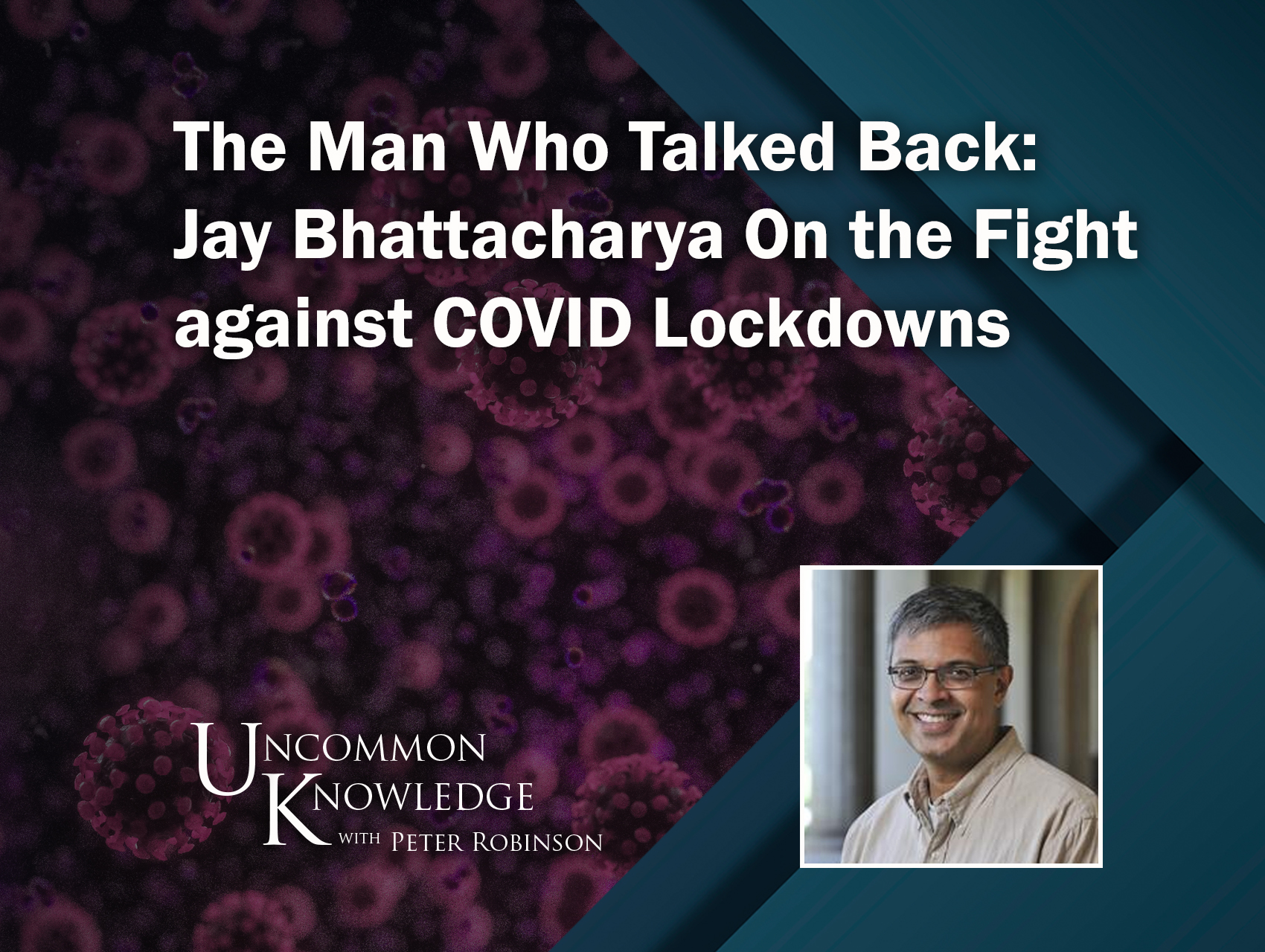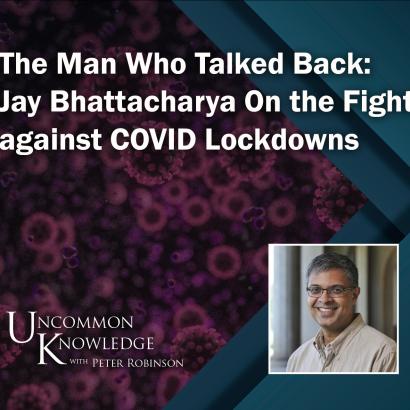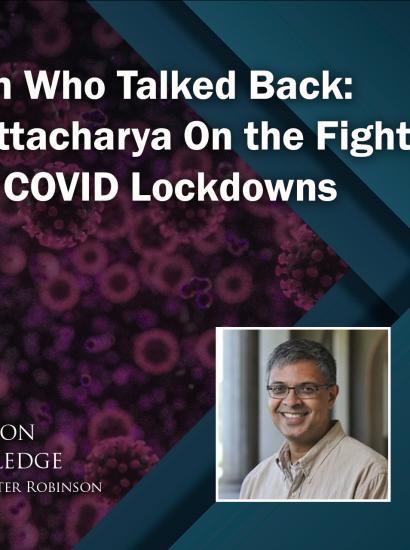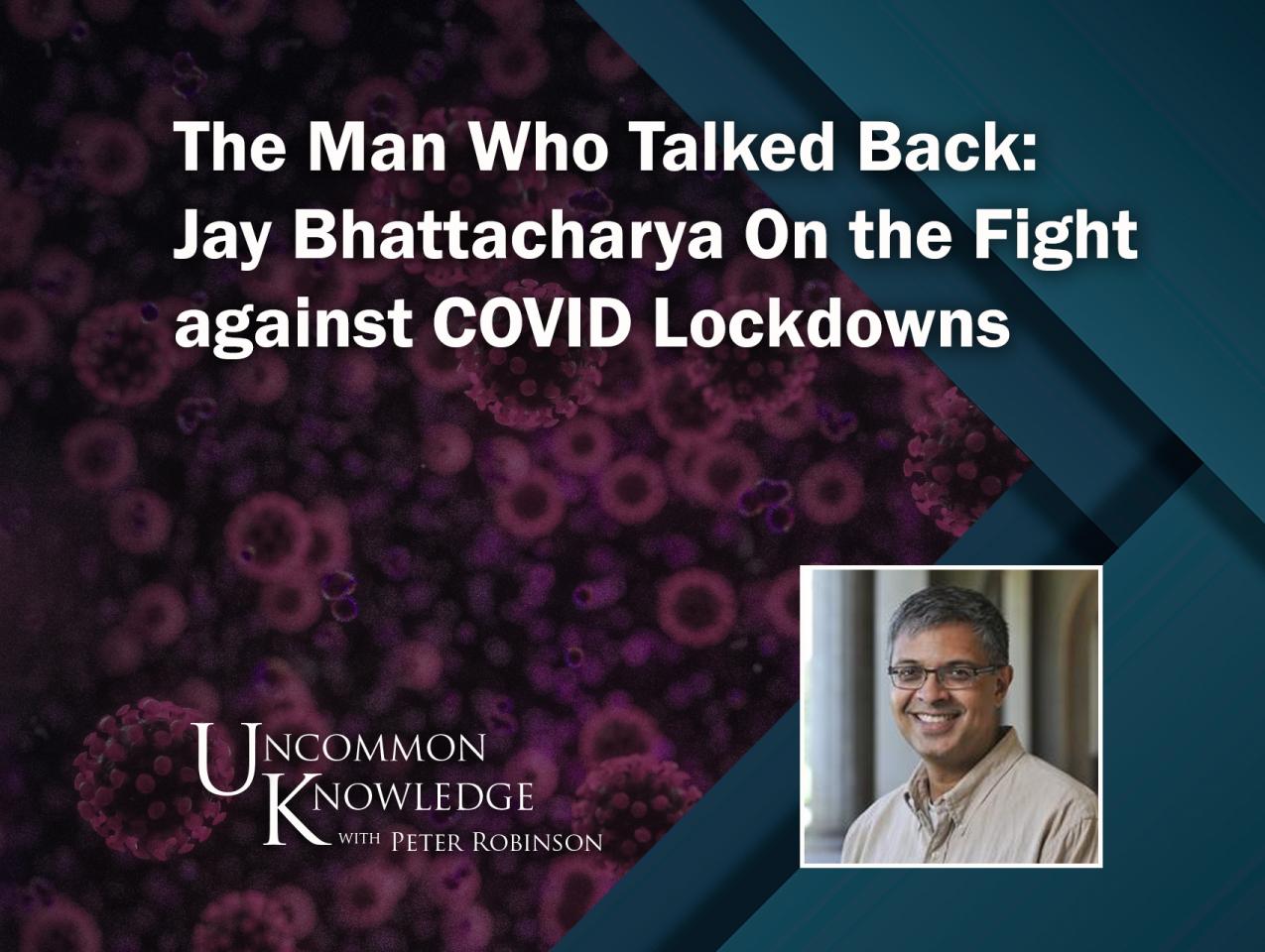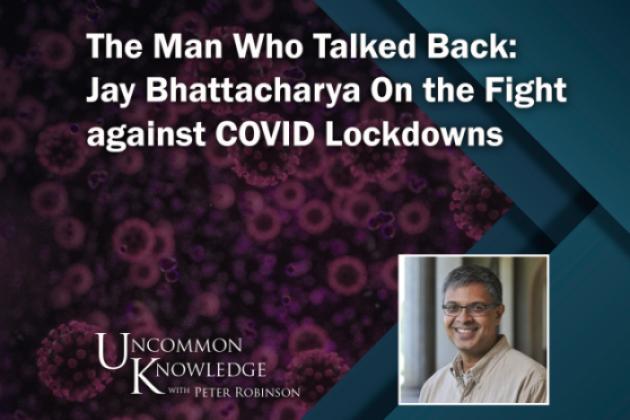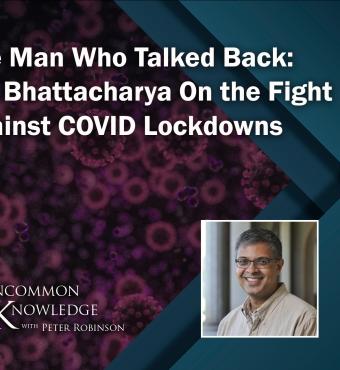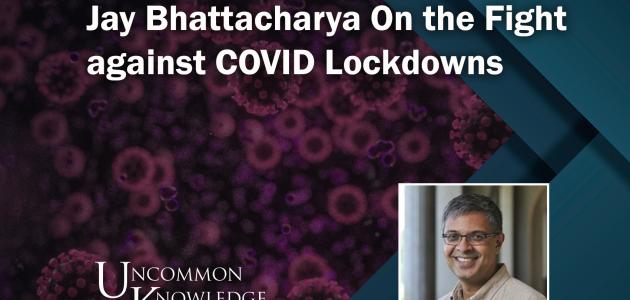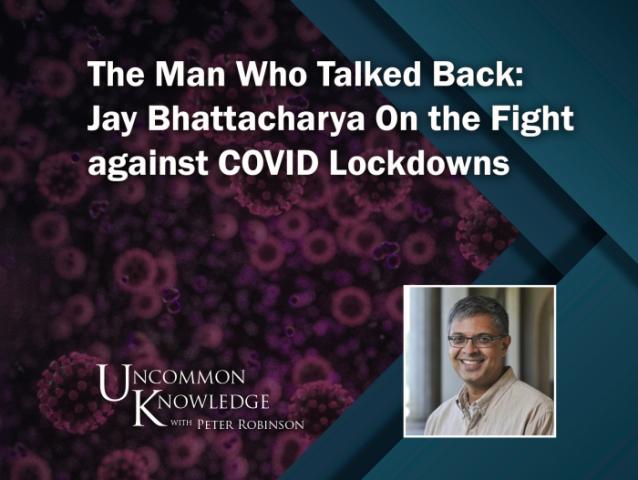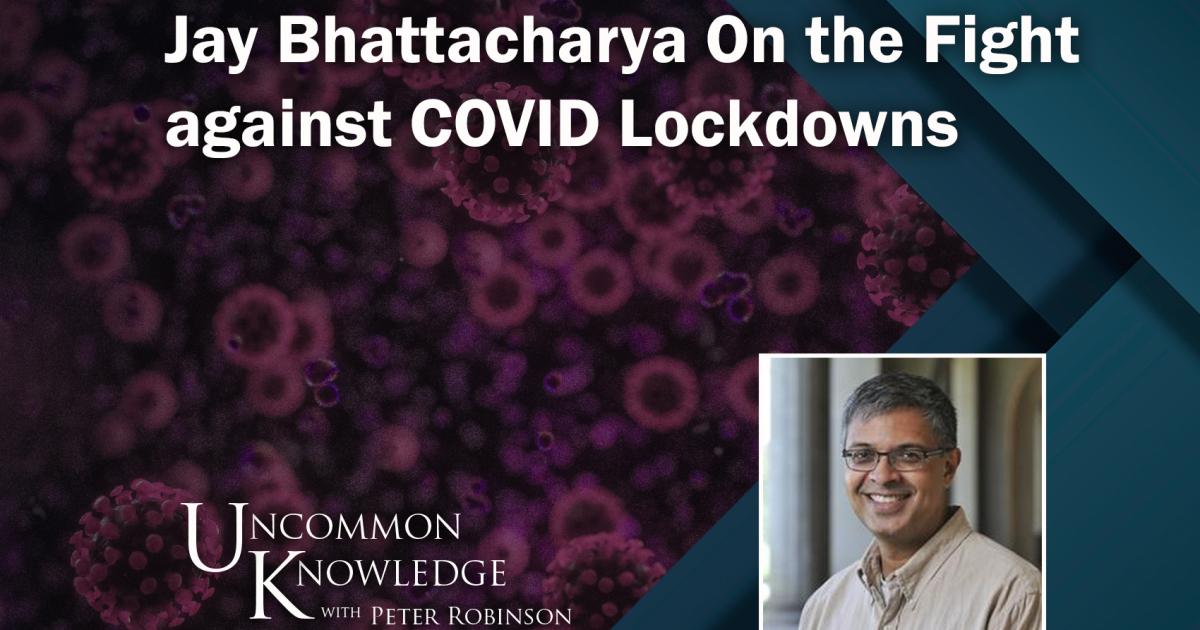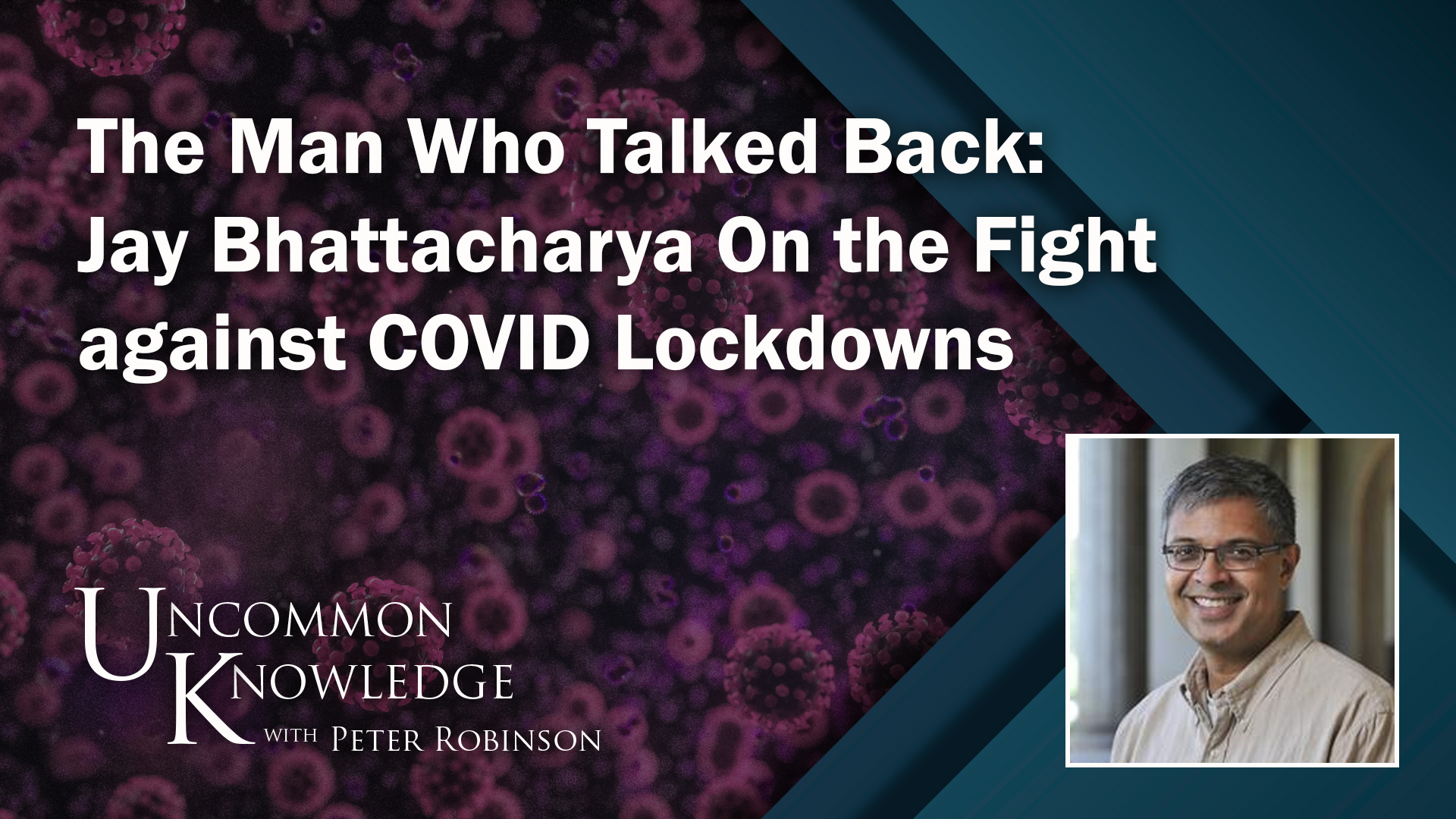Prior to spring 2020, Jay Bhattacharya was a well-respected but little-known epidemiologist and Stanford Medical School professor. But when the COVID pandemic broke out that March, Dr. Bhattacharya was thrust into a leadership role as coauthor of the groundbreaking Santa Clara Study, one of the first comprehensive looks at how the disease spread and impacted populations, and as one of the principals behind the Great Barrington Declaration, one of the first public declarations questioning the lockdown policies then being instituted worldwide. His public interrogation of these policies made him a target of public health officials in the US and abroad—including Dr. Anthony Fauci of the CDC and Dr. Francis Collins at the National Institutes of Health in Washington, DC—and placed him in a media spotlight. In this interview, Dr. Bhattacharya reflects on those battles, what we learned, and how we might better manage future pandemics.
To view the full transcript of this episode, read below:
Peter Robinson: Beginning in March 2020, just over three years ago, public health officials locked this country down. One man talked back, arguing that public health officials were getting the fight against COVID all wrong. That got him into trouble, and he's still in trouble today, Dr. Jay Bhattacharya on "Uncommon Knowledge" now. Welcome to "Uncommon Knowledge." I'm Peter Robinson. Dr. Jay Bhattacharya came to Stanford University at the age of 17 and has never left. In addition to his undergraduate degree, Dr. Bhattacharya earned a doctorate from the Stanford Economics Department and an M.D. from Stanford Medical School. Dr. Bhattacharya's now a professor of medicine at Stanford and a fellow at the Hoover Institution. Jay is also one of the three authors of the "Great Barrington Declaration." I'm going to quote that declaration: "We have grave concerns." Jay and his two co authors wrote in that October 2020 document, "We have grave concerns about the damaging physical and mental health impacts of the prevailing COVID-19 policies." Jay Bhattacharya, welcome.
Jay Bhattacharya: Thank you.
Peter Robinson: Jay, let's begin with a clip from your last appearance on this program, which took place on October 13, 2021. My question to you was: what needs to happen?
Jay Bhattacharya: I think the first thing that has to happen is that public health should apologize. The public health establishment in the United States and the world has failed the public.
Peter Robinson: "The first thing that has to happen is that public health should apologize." Dr. Anthony Fauci, now retired but, during the lockdown, the director of the National Institute of Allergy and Infectious Diseases, has he apologized?
Jay Bhattacharya: No.
Peter Robinson: Dr. Francis Collins, again, now retired but, during the lockdown, director of National Institutes of Health, has Dr. Collins apologized?
Jay Bhattacharya: No, unfortunately.
Peter Robinson: Federal public health officials, state public health officials, county public health officials, put them all together, and you get several thousand public health officials in this country who are responsible for locking counties down, states down, the country down. As far as you're aware, have any of them apologized?
Jay Bhattacharya: Think very, very few have acknowledged any errors at all.
Peter Robinson: All right, what we know now. Last year, Johns Hopkins performed a survey of the literature on lockdowns. We're defining lockdowns here as government mandates, quote, "such as policies that limit internal movement, close schools and businesses, and ban international travel," close quote. The conclusion of the Johns Hopkins study, that, on average, lockdowns caused a reduction in COVID deaths of only 2/10 of 1%, does that sound right? You read all of these things, so you understand it in ways that I couldn't begin to, but does that conclusion sound about right? And if the benefit of locking down the country was a reduction in COVID deaths of 2/10 of 1%, what do we know now about the costs?
Jay Bhattacharya: Peter, it is absolutely right. I don't know the specific number, but the magnitude of the protective effect of the lockdowns, if it's not zero, it's very, very close to zero. And for a very simple reason, you can see why it's right. The lockdowns, if they were to benefit anybody, it benefited members of the laptop class who actually had the wherewithal to stay home, stay safe while the rest of the population served them. Our societies are deeply unequal. It's a very small fraction of the world population that actually could stay home and stay safe. And so, when the lockdowns happened, a very large number of people essentially were left on the outside. They had to work to feed their families, to take care of their elderly parents or whatnot, and that meant that the lockdowns had no chance of actually working. The people that conceived the lockdowns have an extent of naivety about how societies work that it just boggles the mind. And then, you asked me, again, about the harms from the lockdowns.
Peter Robinson: Yeah, what do we know? What do we know?
Jay Bhattacharya: They're tremendous, and we're still just beginning to count them, right? So domestically, for instance, I think there's now a broad consensus that the lockdowns harmed our children. In many places, including California, children did not see the inside of a physical classroom for nearly a full year and a half. The consequences of that play themselves out with deep learning losses. By the way, it's concentrated on minorities and poor populations who didn't have the wherewithal to replace the lost in-classroom learning, but it plays itself out over a long period of time. The social science literature from before the pandemic documented in detail about how valuable investments in education are for the health of children. If you deprive children of education for even short periods of time, it turns out it leads to a lifetime of lower income, worse health, even shorter lifespans. One estimate from early in the pandemic, published by the editor of "JAMA Pediatrics," found that just the spring lockdowns in the United States alone cost our children 5 1/2 million life years in expectation. That's yet to come, but it's coming. The toll on skipped cancer screenings, again, starting to see it, but the full extent of it is yet to come. In the poorer parts of the world, the consequences have been absolutely devastating, something like 100 million people thrown into dire poverty, $2 or less of income. Millions of people were-
Peter Robinson: India, Africa.
Jay Bhattacharya: You name the poor people in the poor country. The lockdowns harmed them. The estimates from the World Food Program is that 100 million people were put into dire food insecurity, near starvation. We haven't yet begun to count the deaths from that yet, but it's gonna be in the millions. And the children in poor countries... I'll just take Uganda as a good example of this. They don't have Zoom schools. They just had no school for two years, unless, again, if they were in the laptop class, a relatively small number. 4 1/2 million Ugandan kids never came back to school after two years out of school, and it turns out many of them, especially the little girls, were sold into sexual slavery or are married off as child brides. Many little boys were put into child labor. Their families were so poor that they faced this terrible choice between starving their kids or prostituting them. We're in a situation where the harms of the lockdowns have become and are becoming clearer and clearer every day, and the benefits, in terms of protecting people from COVID, it's becoming clearer that they did none of that. I think about 1.2 million people have died of COVID in the United States, and you have nearly seven million worldwide. At least, those are the official estimates. What benefit did the lockdowns actually have?
Peter Robinson: All right, let's go through the life of Doc Jay as this is taking place. Let's begin... In March 2020, as the lockdowns were being announced, you felt uneasy about them immediately. I know this because we're friends and we were talking about it. I had no idea what was happening, and you said what's happening here is wrong: "I think, is wrong." You were actually quite scientific about it, which leads me to the study that you conducted, the seroprevalence study that you conducted right here in Santa Clara County. The whole public health apparatus in the country is moving toward a lockdown, and you, to my astonishment... I thought, "Well, there must be hundreds of these seroprevalence studies being done," and it turned out the one that you performed here in Santa Clara County with a couple of colleagues at the medical school was the first seroprevalence study ever conducted and you discovered that the population was already much more infected with COVID than public ill health authorities had understood. I thought, stopping by your office and chatting as we do, you will receive the thanks of a grateful nation. These are serious findings. You didn't. What happened instead?
Jay Bhattacharya: It's kind of a painful story. That study, which I was the senior author on in early April 2020, the first week, in Santa Clara County, we found that about 3% of Santa Clara County had antibodies already, and as you said... Well, there's several implications. One is that that meant the mortality rate from the disease was much lower than people were saying. The World Health Organization already said that the mortality rate was 3 or 4%. They were saying technically something called a case fatality rate, the number of people identified with COVID, usually in the hospital back in those days, divided by the number of people... Again, you count the number of people that died among that set. And then, you get 3 or 4%. That is a deeply misleading number. 3 or 4% of people who get COVID do not die from COVID. That's just a lie. What that seroprevalence study found was that it was 0.2% so two out of 1,000. Now, that's still a big number. It's not the flu, and we also found a very, very steep age gradient.
Peter Robinson: Oh, you did pick that up in the seroprevalence. I forgot. Go ahead. Sorry, go ahead.
Jay Bhattacharya: Children just didn't die at very high rates from COVID, especially healthy children, one in a million, on that order, whereas older people had much higher rates of death from COVID. We saw that in the seroprevalence study. It was much more widespread; I think, 40 or 50 infections for every case that public health knew about at the time. The third implication is that... It's 3%, right? Very infectious disease. That means we still have a long way to go before the pandemic's over, those were the three implications of that study. We did a very similar study in L.A. County the next week after that and then another, more nationwide study, less representative, of Major League Baseball employees, and what we found in L.A. was 4%, the prevalence of the infections. 4% of the L.A. County adult population had evidence of having had COVID already and recovered. The same exact infection fatality rate. It was an independent confirmation of that study.
Peter Robinson: And by the way, if I may add, in subsequent weeks and months, the findings of these studies would be confirmed again and again and again and again.
Jay Bhattacharya: 100-plus studies like this, yeah. We found exactly what we found, over and over again.
Peter Robinson: And so, instead of thanks, you received?
Jay Bhattacharya: Okay, at Stanford, at first, there were a lot of very... It was actually quite touching. A lotta people volunteered to help with the study. We put the study together in, basically, three weeks' time. We worked very closely with the Human Subjects Review Board at Stanford, who helped us with the script, made sure we protected the people that volunteered their finger-prick blood, protected the people that were drawing the blood and drawing the samples, and so on. It felt quite good. It felt like a community coming together to do a very important bit of science so that the world at large could learn more about this deadly disease that was floating around. When we first got the results of the study, when it first started coming in, that was when things really turned negative. There was, for instance, a pathologist here at Stanford who wanted to make their own test kit. We had actually used a test kit that had been gifted to us by some amazing folks who work with Major League Baseball on steroid testing. And he had gotten these test kits from a Chinese company, actually, working with an American affiliate, and he reached out to me after he saw a "Wall Street Journal" piece I had written in March of 2020 and said, "Look, I don't wanna use these for Major League Baseball and make money. I wanna use them for science. Can you use them for science?" It felt really good, but the test kit itself, just like any medical apparatus, has some error: false positives, false negatives. And there was really a race among lab folks to create their own test kits, including here at Stanford, and then market them. We got a email from the head of the Pathology Department and then from the Department of Medicine saying, "Well, people are concerned about your test kit." Now, we'd had a lot of independent labs that checked the validity of the test kit, and we found... I think it was a small error, 0.5%, in the false-positive rate, but we have these statistical methods to adjust for this, right? It's an interesting statistical question, but it's not something that was gonna invalidate the results of our study, which were published, by the way, in the "International Journal of Epidemiology." But Stanford made us change, after the fact, the protocol of the study. I've been a Stanford professor for 20-some years up to that point, and I've never seen or heard of Stanford forcing professors to independently change the results, or change the protocols, of a study after the data collection had already been done. Because of the concerns of the pathologists and the medical school, they made us bring back... Okay, I'm sorry to do math on you, Peter, but I have to do just a bit of math.
Peter Robinson: Oh, go right ahead. You have to explain what it means to change a protocol because I don't understand.
Jay Bhattacharya: I'm gonna explain specifically.
Peter Robinson: Okay, go ahead.
Jay Bhattacharya: We have 3,000 people that we sampled in Santa Clara County. 50 of them were positive. Now, we had to do some waiting because there were too many people coming from richer parts than the poorer parts. That's how we got the 2.8% prevalence. But anyways, we had 50 out of 3,000 positive. Okay, Stanford made us bring those 50 people back into the lab, even though that was part of our original protocol, and test them; that means draw blood from them; and have them tested using the pathologist test kit rather than the test kit we used, on the premise that the pathologist test kit was completely accurate and ours was crap. He found that, of those 50, 35 out of those 50 were positive on his test kit. Now, let's say his test kit is 100% accurate. Well, what that means is that we have 15 people that we identified as positive that he identified as negative. False positives, right?
Peter Robinson: Right.
Jay Bhattacharya: So he sent an email saying, "15 out of 50 false positives, 30%." That's devastating. That means you can't use that test kit, everything we did was terrible and wrong. The problem is the math. If you have 15 false positives, it's not outta 50. It's out of 3,000.
Peter Robinson: Outta 3,000.
Jay Bhattacharya: Which is a 0.5% error rate.
Peter Robinson: Which is exactly what you... You knew the error rate going into it.
Jay Bhattacharya: Exactly, so Stanford, then, when we found this out... I immediately noticed that the denominator was wrong, I pointed this out to the folks at Stanford in the medical school that were forcing us to change our protocol, and they told us we were not allowed to tell the world about it, at a time when people were questioning the accuracy of our test kit, the correctness of our study, and so on.
Peter Robinson: Okay, there's more to that story, but people will read that in the book that you're going to write sooner or later; if I have anything to do with it, sooner. Let's move on from that seroprevalence study here at Stanford, which, again, I repeat... First of all, it was your idea to be helpful. You noticed that no one had done one yet. You moved as quickly as you reasonably could. You came back with results that were valid and that were confirmed again and again. All right, the "Great Barrington Declaration," in October 2020... Again, I'm going to quote this from the "Great Barrington Declaration," which you co authored with two others, whom I'll mention in a moment: "As infectious disease epidemiologists and public health scientists, we have grave concerns about the damaging physical and mental health impacts of the prevailing COVID-19 policies and recommend an approach that we call focused protection," close quote. Instead of shutting the country down, you focus on people who are at risk, particularly older people, because of this age gradient you discovered. This is signed by Dr. Jay Bhattacharya of Stanford, Dr. Martin Kulldorff of Harvard, and Dr. Sunetra Gupta of Oxford. We now know that just four days after you published the "Great Barrington Declaration," Dr. Francis Collins, director of NIH, wrote an email to Dr. Anthony Fauci, director of NIAID, quote: "This proposal from the three fringe"... Lemme just repeat that: Jay Bhattacharya of Stanford, Sunetra Gupta of Oxford, and Martin Kulldorff of Harvard. "This proposal from the three fringe epidemiologists seems to be getting a lot of attention. There needs to be a quick and devastating published takedown of its premises," close quote. A week later, Dr. Collins spoke to "The Washington Post'' about the "Great Barrington Declaration," quote: "This is a fringe component of epidemiology. This is not mainstream science. It's dangerous," close quote. Still later, Dr. Collins said on Fox News, quote, "Hundreds of thousands of people would have died if we had followed that strategy," close quote. Jay, what's going on here?
Jay Bhattacharya: We wrote this "Great Barrington Declaration" in October of 2020. We had already tried the lockdown in March and April of 2020, and the disease had come back. The effective implied promise is two weeks to flatten the curve and then we can figure out what to do about the disease, on the basis, it turns out, of advice from people like Francis Collins and Tony Fauci to prominent government actors, including President Trump. The lockdown strategy, in part, was a reaction to observations of what happened in China in January of 2020. The Chinese had locked down their society, especially Wuhan and Hubei Province around it, and American bureaucrats, like Tony Fauci, looked at this and thought, "Okay, what the Chinese did worked. We need to do it, too." Now, these are tremendously-
Peter Robinson: Wait, wait, how did they know that it worked? They believed Chinese data?
Jay Bhattacharya: Yes.
Peter Robinson: All right. Carry on.
Jay Bhattacharya: They'd already staked their reputations on this strategy. And why fringe epidemiology? Why would the head of the NIH go out of his way to do this devastating takedown? By the way, the devastating takedown turned out to be a "WIRED" magazine article.
Peter Robinson: That was the best they could produce?
Jay Bhattacharya: Well, you see a response to that email that you cited. Tony Fauci responded to Francis Collins with a "WIRED" magazine article. They very likely cooperated with the... Anyways, the problem was that you had thousands and thousands of scientists, Stanford, Harvard, Oxford, saying that what they were doing, their strategy, was a mistake, that there was no scientific consensus in favor of their strategy.
Peter Robinson: And by the way, when you say thousands and thousands of scientists, you put up the "Great Barrington Declaration" online and invited anyone who wanted to associate himself with it to sign, and you did have thousands and thousands of signatures.
Jay Bhattacharya: Tens of thousands of doctors and scientists and epidemiologists, including a Nobel Prize-winner. It wasn't actually a fringe idea. In fact, it was the standard policy for how to manage respiratory virus pandemics that we'd followed for a century. If you go back to March of 2020, you can see op-eds in "The New York Times," in "Washington Post," and elsewhere by leading epidemiologists that look, for all the world, like the "Great Barrington Declaration." It's the least original thing I ever worked on my entire life, Peter. The problem for Tony Fauci and Francis Collins was that they had... They had to solve a PR problem. You have prominent scientists saying, "Look, what these guys are doing is not actually the right strategy." That normally should've led to a debate, a discussion, some sort of conversation because, if you're gonna implement a policy as devastating as a lockdown, you actually need to have scientific consensus. It's not okay to say that we should lock society down when only a part of scientists agree with it, especially when it's clear it didn't work just a few months earlier, and it was already clear that it had caused a lot of damage a few months earlier. So they faced a PR problem. They had to make us into fringe characters, fringe actors, destroy us, destroy our reputations, so they didn't have to have that debate. They needed to create an illusion of scientific consensus that did not actually exist.
Peter Robinson: All right, so in that incident, we're not discussing science. We're discussing brutal bureaucratic politics.
Jay Bhattacharya: Yeah, it's hubris.
Peter Robinson: All right, blacklisted on Twitter. You joined Twitter in 2021. Your first tweet, you linked to an article that you had recently written on age-based risks, and you tweet, quote, "Mass testing is lockdown by stealth." Very briefly, what's the argument there? What point were you making?
Jay Bhattacharya: Mass testing of children so that they stay out of school. You test someone who's come in contact with a child, and you keep them out of school for five-seven, however many days until you're certain the kid's negative. That essentially is a lockdown of that child, even though they're not actually at lower risk of spreading the disease in the population. What does the kid do at home? What if it's a crowded home? What if the kid's healthy? Do they not go outside and play with other kids? You had already, from the spring of 2020, evidence from Sweden, which kept schools for kids under 16 entirely open, not one child died that spring from COVID and that the teachers were actually at lower risk of COVID than the population of other workers at large. Being around kids actually protected them, in some sense, because the kids are not super-spreaders. They actually are less efficient spreaders than adults. You already had all that evidence, so why are we testing to keep kids outta school? It just harms them with very little epidemiological benefit.
Peter Robinson: All right, thank you for that explanation. And, you continue to tweet. And then, late last year, Elon Musk takes over Twitter, and the company releases internal emails and documents, showing, among other things, that you had been intentionally censored, and not long after that, Elon Musk gets in touch with Dr. Jay Bhattacharya and says, "Come on up here to headquarters, and take a look. I'd like you to see this with your own eyes." What did you see?
Jay Bhattacharya: It was surreal, Peter. When I joined Twitter, that was October, no, August 2021, and I actually got a lot of followers. I had 200,000 followers, I think, by the time-
Peter Robinson: Stop rubbing it in. I have 12,000.
Jay Bhattacharya: I've tried to help you on Twitter, Peter. No, now, the thing is is the blacklist that they put me on was insidious, right? I could put a tweet out. I thought I was reaching... The purpose of going on Twitter isn't to reach people that already agree with me. The purpose of my going on Twitter was to tell other people who hadn't heard of my message or about lockdowns, and so on, COVID policy, that maybe disagreed with me, to engage with them. The blacklist made sure that my tweets, my message, never reached that audience. It only reached people that already followed me.
Peter Robinson: That already followed you?
Jay Bhattacharya: Yeah.
Peter Robinson: I see.
Jay Bhattacharya: Which is an insidious way of keeping me in a box, without my even knowing about it.
Peter Robinson: And Twitter was banning you on its own initiative? Or it was being prompted to do so by outside-
Jay Bhattacharya: I don't know that for certain about the blacklist, but I very strongly suspect that it was government actors that had me on a blacklist. I can give you some evidence for that so I don't sound too much like a conspiracy theorist.
Peter Robinson: Give us a sentence or two of evidence.
Jay Bhattacharya: Yeah, there's a lawsuit by the Missouri and Louisiana Attorney General's Offices against the Biden administration, where we have deposed Tony Fauci. We've deposed aids to the surgeon general, aids to Jen Psaki, the former communication director of the White House. We've found direct instructions and threats from the White House and many agencies within HHS, Health and Human Services, to Twitter and other social media companies.
Peter Robinson: Facebook, and so forth.
Jay Bhattacharya: Essentially threatening them, unless they censored people and ideas that they didn't like.
Peter Robinson: All right, here's what you put up. Here's what you tweeted after learning that you'd been blacklisted. By the way, the term blacklist.
Jay Bhattacharya: Isn't it wonderful?
Peter Robinson: Is politically incorrect in itself, but it's Twitter's term. They actually put you on a blacklist, all right. Quote, quoting you, "the thought that will keep me up tonight: censorship of scientific discussion permitted policies like school closures, and children were hurt," this is the story of your life during COVID, beginning with the seroprevalence study: "Shut up." "Great Barrington Declaration," "you're a fringe epidemiologist. Sit down, and shut up." Twitter, "if he won't shut up, we're gonna censor him." Why? What were they thinking? This isn't science.
Jay Bhattacharya: It's not science. I think that, by 2021, we already had tremendous policies that kept kids out of school that forced people to be vaccinated, even though the evidence was that the vaccine doesn't stop transmission. You’ve already harmed the lives of so many people. It's just inconvenient to have Stanford, Harvard, Oxford professors around saying it wasn't necessary, that there were other strategies that might've worked better, that might've protected people better without the collateral harm. That's the lie. When I met with Elon, it was surreal. I drove up toward headquarters, which is in San Francisco. The whole way up, I'm thinking to myself, "This trip cost Elon $44 billion," and I saw with my own eyes. It literally said, "Blacklist." They have a database called Jira, and they put me on this blacklist. I saw prominent media people asking for tweets of mine to be brought down, for me to be censored. It was a striking thing to know that there were actors in the media environment, to know from the Missouri-versus-Biden case, and in the government who wanted to silence me.
Peter Robinson: Now we come to what we oughta learn. What should we know? And what should we do now? Three states, there was a study of three states this spring by the Paragon Health Institute. It used an index of state responses to COVID that were created at Oxford University, so we have an objective set of indexing. Illinois, for example, has an average score. California, which imposed some of the harshest lockdowns, has a high score. Florida, which imposed lockdowns but only very briefly and then opened up almost entirely, has a low score. The finding, after adjusting for age and disease... I'm quoting the study: "All three states," high, medium, and low, California, Illinois, and Florida, "all three states had roughly equal outcomes, suggesting that there was no substantial health benefit to more severe lockdowns. Florida, however, easily surpassed California and Illinois in educational and economic outcomes." The kids went to school. The economy remained open. That all sounds right to you?
Jay Bhattacharya: Yes.
Peter Robinson: So again, the lockdowns were a mistake. I'm saying to you, you who... This is almost the wrong word to use for you because it's just so counter to your temperament and personality, but you campaigned against lockdowns throughout COVID. You have no reason to regret that?
Jay Bhattacharya: No, I think that was the right thing to do. I'm not, by nature, an activist.
Peter Robinson: I can attest to that.
Jay Bhattacharya: But every aspect of lockdown just fills me with... It has nothing to do with science. It's damaging to the poor. It's damaging to kids in ways that public policy never ought to have done, and we did it out of ignorance and fear and hubris. You know, Sweden, the all-cause excess deaths in Sweden is something like 3%. It's among the very, very lowest in all of Europe. In other words-
Peter Robinson: And repeat. Sweden did not lock down.
Jay Bhattacharya: Sweden did not lock down.
Peter Robinson: Schools stayed open.
Jay Bhattacharya: Very famously.
Peter Robinson: The economy continued to function.
Jay Bhattacharya: Yeah, and they have lower mortality than locked-down Germany, locked-down UK, locked-down France, even locked-down... I think they're surpassed Finland and Norway. It's almost no excess deaths. Imagine that. Imagine if we'd followed a policy like Sweden. We could've avoided all the harm to our children. We could've avoided all the suffering caused by the lockdowns: the closed businesses, the unemployment, all of that, the economic harm, where we'd spend trillions of dollars; the inflation is a consequence of the lockdowns; and still protected our people better from COVID.
Peter Robinson: So the question now is how do we do better next time around. Commission, here's an idea. Jay Bhattacharya with Martin Kulldorff writing in "The Wall Street Journal" in June of 2021, this is almost two years ago: "The first step to restoring the public's trust in scientific experts is an honest and comprehensive evaluation of the nation's pandemic response. Senators Bob Menendez, Democrat of New Jersey, and Susan Collins, Republican of Maine, have introduced a bill that would establish a COVID commission," close quote. Now, there's a good idea, a bipartisan COVID commission. What has the commission found?
Jay Bhattacharya: They're actually meeting today to report the results. It's a whitewash, right? It doesn't mention the possibility of focused protection. In effect, you can get a sense of how the establishment that imposed the lockdowns is treating this. They have a once-in-a-generation opportunity to actually do an honest introspection and reform the processes that led to this public policy disaster. Instead, they're giving awards to Tony Fauci. Instead, they're patting themselves on the back, saying that what they did was absolutely necessary. They're blaming, for instance, the disaster on misinformation. I think the head of the FDA, Califf, did an interview with some public radio station saying that misinformation is the number-one cause of death. It is irresponsible in the extreme and depressing to watch, right? I think the problem is, if you don't have an honest evaluation of what happened and the disaster that happened, this will happen again, Peter.
Peter Robinson: Yes, right, okay, the lawsuit, you mentioned this lawsuit a moment ago. The attorneys general of Louisiana, Missouri, and other states have brought suit against the Biden administration for censoring social media during the pandemic. You've joined the suit. Lemme quote, for a moment, from the testimony of John Sauer, if I'm pronouncing his name correctly, special assistant attorney general for Louisiana. This is testimony he gave to the Senate Judiciary Committee this past March. By the way, Sauer is a graduate of Notre Dame, Harvard Law School, and Oxford as a Rhodes Scholar, so we're not talking about a crank here. This is from his testimony, quote: "What we discovered." And excuse me, he's talking about the discovery process that you mentioned a moment ago. People have been deposed. Emails have been examined, and so forth.
John Sauer: What we obtained was astonishing, staggering, and horrifying, a veritable army of federal officials, pressures, threatens, coerces, colludes with, demands, and deceives social media platforms to censor online speech.
Peter Robinson: You experienced that. I'm just asking you now as a normal consumer. You're not a normal consumer of news. You're a normal consumer of news, but in recent months, you've become especially attuned to news about matters such as this. Has that testimony, has your lawsuit, received the kind of attention that it feels it merits?
Jay Bhattacharya: I think this is the most important First Amendment case since "Pentagon Papers" 50 years ago, and it's received almost no attention from the news media, and it's actually kinda shocking because it's the news media that, in principle, ought to be standing up for free speech.
Peter Robinson: Right, right, okay, the political system. We've talked about Fauci and Collins, who were federal officials, but the lockdowns are largely a matter of state law, and in many states, including our state of California, the state tends to defer to county health officials. So the lockdowns are largely imposed by county and state officials, and now, some 20 states have enacted laws that curtail the powers of those health officials. The laws vary a little bit from state to state, but they require public health officials to narrow the scope of their actions to achieve specific health purposes. They call for expedited judicial review of such actions, and they ensure that actions will automatically expire after a certain period of time. Okay, is that a good idea?
Jay Bhattacharya: Yes. I think the problem is that what happened is you have the CDC, which issues guidance; you have the NIH, which issues proclamations from on high, I guess, of who's fringe and who's not; and the local and state officials essentially respond as if it were Holy Writ. It's not formal regulation that's been subject to public comment or whatever. It's just a CDC guidance, you know? They tell you not to eat sushi when you're pregnant or something, and usually, people feel free to ignore it, but during the pandemic, these kinds of guidances were used in court cases to defend indefensible things, lockdowns, closures of businesses, that had no real justification in terms of reality.
Peter Robinson: And the other point, from the point of view of the political system, almost from the point of view of political theory, there are over 2,000, I think, just short of 3,000, counties in this country. This varies a little bit from state to state, but most counties have a public health official, and in most cases, that public health official is appointed, not elected. Most people have never even heard of them, and suddenly, it emerges that they have... I was about to say dictatorial powers. I'm gonna stick with dictatorial powers. You have to live a certain way because they say so, and there's no redress. Okay, so these state laws are a good idea. Does it bother you that it's only 20 states? And does it bother you that almost all; I think all of the 20 states; "almost all," let me stick with that; are run by Republicans? That there's now a partisan divide in the response to the lockdowns?
Jay Bhattacharya: It's a disaster, Peter. It's a disaster that it's become a partisan thing. Public health, when it is partisan, is a failed public health. It's not like politics. You can't just win 50% plus one and say you've done a successful job in public... You need 95% of the public to honor and respect what you're saying, or else you've failed; trust what you're saying, or else you've failed because public health is for everybody. It's not a partisan issue. The fact that it is partisan... I'm in favor of the laws, but I wish that those laws were extended to the rest of the states. I think it actually would help public health because, at that point, then, public health officials couldn't act as dictators. They would have to reason with the public and tell the public, "Look, here's the evidence for why we're asking you to do this," and if they're persuasive, the public would agree. This is what happened in Sweden. In Sweden, 95% of people trust Swedish public health because they were honest about their mistakes, honest about their reasoning. They treated adults like adults.
Peter Robinson: All right, Jay, if I could make you dictator for a day... I've just been... What do you wanna see... We've talked about... There's a lawsuit. It's not getting the attention it deserves. There's laws. They're good, as far as they go. But it's only 20 states, and it's brought into view a partisan divide. This just seems... You have the magnitude of these lockdowns, which damaged millions of people and did very little good, and the response seems puny. It's certainly insufficient. What could still be done?
Jay Bhattacharya: Well, first, don't make me dictator for a day. I think that would be a mistake. I think that the response is coming. It's not done yet. It's unfortunate that we haven't had an honest evaluation. The extent of harm to people is so much that it demands a political response, and I think that political response will... What form it'll take I don't know. You're the political expert, but the expression of the people that were harmed by the lockdowns, the expression of the people that were harmed by COVID, the fact that public health did not actually end up protecting people, ended up harming people, that demands a political response, which, I think, will inevitably come.
Peter Robinson: All right, a few final questions, Jay. Holman Jenkins in "The Wall Street Journal," quote: "The world inevitably will face new respiratory viruses. There seems to be no good reason nature would afflict us with a disease that spreads as easily as the flu or COVID and is significantly more deadly, but neither can that be ruled out." Are we ready for the next pandemic?
Jay Bhattacharya: We're gonna lock down again with the next pandemic, guaranteed. If the current configuration of power in public health and politics stands, we will respond by saying, "Look, the lockdown's the only way," and just as happened in 2020, it'll be the laptop class that'll benefit, and the poor and the vulnerable and children who will be harmed.
Peter Robinson: All right, we've been talking about lockdowns, but briefly, if I could ask you what we know about other aspects of the response. Just briefly, if you could take us through these. Masking, February of this year, the Cochrane Library conducted what seems to be the most rigorous study of the literature on masking. At least, it's the most rigorous of which I'm aware; the conclusion, quote, "we are uncertain whether wearing masks or N95 respirators helps to slow the spread of respiratory viruses based on the studies we assessed," closed quote. We're uncertain? The lead author of the study, the Oxford epidemiologist Tom Jefferson, put it more bluntly, quote: "There is just no evidence that masks make any difference, full stop," close quote. That sounds right to you?
Jay Bhattacharya: Yes.
Peter Robinson: We were all told we couldn't go into a store, we couldn't go to church, we couldn't leave our homes unless we had a mask. And they make no difference?
Jay Bhattacharya: They've been now... Before the pandemic, there were something like a dozen randomized studies of masking and the prevention of spread of influenza; three randomized studies during the pandemic on COVID. And all of them either find no effect or have trouble finding any effect at all, or if they find an effect, it's a tiny, tiny effect.
Peter Robinson: Okay, all right, here's what I think is some good news, the vaccines. Dr. Fauci... This was last summer: "Even though vaccines don't protect particularly well against infection; oops, we thought they did, but they don't; they do protect quite well against severe disease leading to hospitalization and death," closed quote. That bit we got right, correct?
Jay Bhattacharya: Yes, I think so.
Peter Robinson: The vaccines, we did have this project. What was it called? Project Light Speed or?
Jay Bhattacharya: Operation Warp Speed.
Peter Robinson: "Warp Speed," Warp Speed. I'm a little vague on the "Star Trek" terms, but Operation Warp Speed, the government got that right. That was one place where the government mobilized resources and we got it right. They don't protect against infection, but they do help keep you alive if you get it, right?
Jay Bhattacharya: Yeah, I think that that's true, but there are some nuances that are very important there. First, if you've had COVID and recovered, I don't know how big an improvement there is. You already have pretty good protection against severe disease and death on reinfection.
Peter Robinson: Yeah, from immunity.
Jay Bhattacharya: Yeah, if you've had COVID and recovered. The vaccines might help a little but not as much as if you were completely immune naive. Second, it's gonna have a much bigger benefit for older people than for young people. For young people, the risk of death is very low, to begin with. Third, there are some side effects from the vaccine, especially young men and myocarditis, so it's not necessarily wise just because it reduces death that, automatically, everyone should automatically get it.
Peter Robinson: Okay, so this brings us to the question of the mandates. They varied from state to state, but we do know that all federal workers were required to get vaccinated to keep their jobs. We know that, at this moment as we sit here recording this, foreign visitors are not allowed into the United States without proof of vaccination. Did these mandates make sense?
Jay Bhattacharya: No, just as a matter of policy and economics, if my vaccine only matters for whether I die if I get COVID, well then, it's a personal medical decision, right?
Peter Robinson: Right.
Jay Bhattacharya: If my vaccine protects you against COVID, then there might be some public policy around inducing me to get the vaccine, so a necessary condition for the mandates to be right is that the vaccines stop transmission.
Peter Robinson: And they didn't.
Jay Bhattacharya: They don't. After two months, the protection against infection drops pretty sharply. Personally, when I was vaccinated in April of 2021, four months later, I got COVID. I think that's the experience of many, many people that've been vaccinated. The vaccines only protect you against getting COVID for a very short period of time.
Peter Robinson: And they don't prevent you from passing it on.
Jay Bhattacharya: That's correct.
Peter Robinson: All right, okay, Jay, this brings us to my last set of questions, and they concern you. We've known each other for a long time, and I can testify that, before COVID, you were completely happy with the quiet life of a man totally devoted to academia, to his research, to his students. You were one of the happiest men I knew. I can also testify that the stress of what you went through took a personal toll on you. You lost 20 pounds. There were plenty of us who were very worried about you, and by the way, while I'm testifying, offering myself as a character witness, you served as an expert witness in any number of trials. You've now spoken at different conferences and events, and I'm delighted that you've made so much money. You have refused any payment whatsoever as an expert witness, no speaking fees, zero.
Jay Bhattacharya: Yep, I don't feel right taking money for my COVID work.
Peter Robinson: Okay, but here you are, Jay. In at least a modest way, you're famous. I have been with you in an airport when people stopped and recognized you. You have over 400,000 followers on Twitter now. What're you gonna do with this platform? What's next? COVID happened. You did what you could. You were largely ignored, honestly. What's next for you?
Jay Bhattacharya: Well, I think I really wanna see the reform of public health happen, so I've been working on... For instance, I just did this document with several of my friends, called the "Norfolk Group Blueprint." It's a blueprint for what an honest COVID commission would do, what it would ask, the questions it would ask, so I'm gonna work very hard on that. I'm not so... I still would like to be a scholar. I am still interested in some of the research questions. I think it's very clear from how scientific institutions responded to COVID that science is fundamentally broken. And so, I'm gonna work with this group that I helped found, called the Academy of Science and Freedom to bring reform to science. I think we have a... I think Martin Kulldorff put it well. During COVID, it felt like science had entered a dark age. Even though there were all these advances, at the same time, you couldn't say something that the powers that be, the high clerisy of science, like Tony Fauci or Francis Collins... You couldn't contradict them without being excommunicated. Felt like the Dark Age. We can't actually have scientific institutions operate that way and still have public confidence in science or expect science to produce the kinds of advances it has, so I'm gonna work toward reform of scientific institutions so those kinds of things don't happen again.
Peter Robinson: If you had a last sentence to offer... You being you, I'll give you a paragraph. Picture a college student. You have college-aged children yourself. Picture a college student who understands because he or she went through it. Universities closed, or students were permitted in dorm rooms but not to attend class, all of that. What do they need to understand about science and the way this country works? Young people, their lives will move on. They'll put the pieces back together as best they can and get on with it. What's the one large idea that you'd like people to really grasp?
Jay Bhattacharya: Peter, I think that it's some young person harmed by our COVID response that will write the last word, the history of this, and they will judge our generation as among the most selfish in history. I hope that they also look and see the promise and fecundity of the scientific method, of free speech, of liberal governance. I think young people and, actually, I hope, not just young people, everybody, within a short period of time, will look back and say, "Why did we jettison those? Those were really productive ideas. We should make sure our institutions support those ideas." That's my hope. I often get accused of being overly optimistic, but I think I'm right on this.
Peter Robinson: You are overly optimistic, Jay. Dr. Jay Bhattacharya of Stanford Medical School and the Hoover Institution, thank you.
Jay Bhattacharya: Thank you.
Peter Robinson: For "Uncommon Knowledge," the Hoover Institution, and Fox Nation, I'm Peter Robinson.







